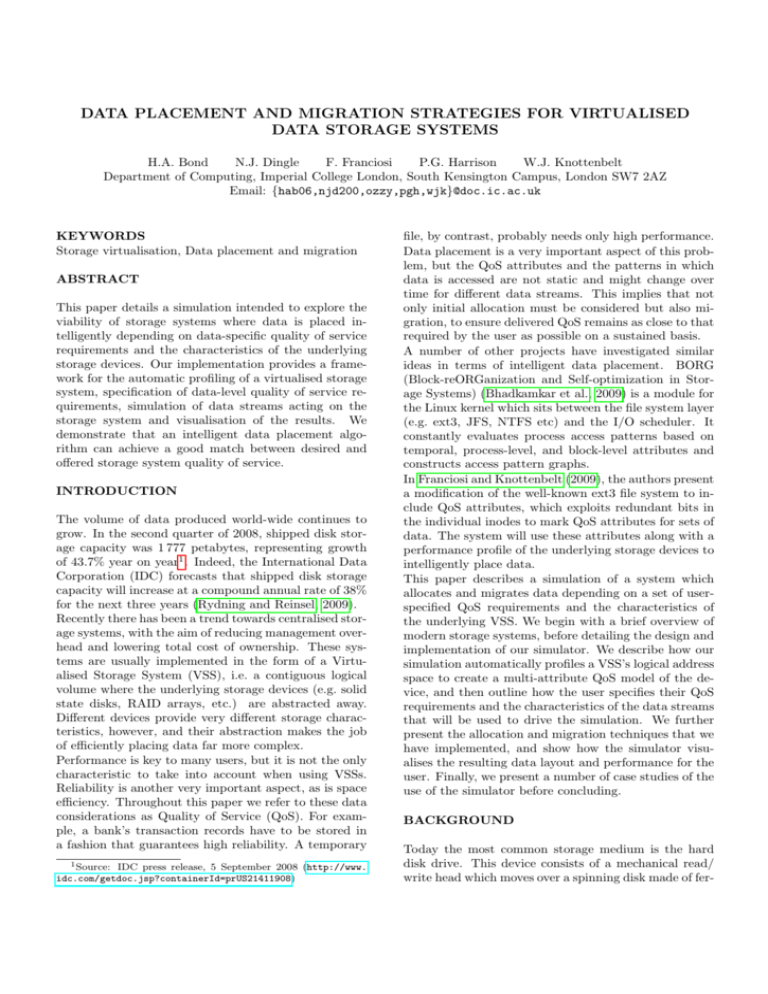data placement and migration strategies for virtualised data storage
advertisement

DATA PLACEMENT AND MIGRATION STRATEGIES FOR VIRTUALISED
DATA STORAGE SYSTEMS
H.A. Bond
N.J. Dingle
F. Franciosi
P.G. Harrison
W.J. Knottenbelt
Department of Computing, Imperial College London, South Kensington Campus, London SW7 2AZ
Email: {hab06,njd200,ozzy,pgh,wjk}@doc.ic.ac.uk
KEYWORDS
Storage virtualisation, Data placement and migration
ABSTRACT
This paper details a simulation intended to explore the
viability of storage systems where data is placed intelligently depending on data-specific quality of service
requirements and the characteristics of the underlying
storage devices. Our implementation provides a framework for the automatic profiling of a virtualised storage
system, specification of data-level quality of service requirements, simulation of data streams acting on the
storage system and visualisation of the results. We
demonstrate that an intelligent data placement algorithm can achieve a good match between desired and
offered storage system quality of service.
INTRODUCTION
The volume of data produced world-wide continues to
grow. In the second quarter of 2008, shipped disk storage capacity was 1 777 petabytes, representing growth
of 43.7% year on year1 . Indeed, the International Data
Corporation (IDC) forecasts that shipped disk storage
capacity will increase at a compound annual rate of 38%
for the next three years (Rydning and Reinsel, 2009).
Recently there has been a trend towards centralised storage systems, with the aim of reducing management overhead and lowering total cost of ownership. These systems are usually implemented in the form of a Virtualised Storage System (VSS), i.e. a contiguous logical
volume where the underlying storage devices (e.g. solid
state disks, RAID arrays, etc.) are abstracted away.
Different devices provide very different storage characteristics, however, and their abstraction makes the job
of efficiently placing data far more complex.
Performance is key to many users, but it is not the only
characteristic to take into account when using VSSs.
Reliability is another very important aspect, as is space
efficiency. Throughout this paper we refer to these data
considerations as Quality of Service (QoS). For example, a bank’s transaction records have to be stored in
a fashion that guarantees high reliability. A temporary
1 Source:
IDC press release, 5 September 2008 (http://www.
idc.com/getdoc.jsp?containerId=prUS21411908)
file, by contrast, probably needs only high performance.
Data placement is a very important aspect of this problem, but the QoS attributes and the patterns in which
data is accessed are not static and might change over
time for different data streams. This implies that not
only initial allocation must be considered but also migration, to ensure delivered QoS remains as close to that
required by the user as possible on a sustained basis.
A number of other projects have investigated similar
ideas in terms of intelligent data placement. BORG
(Block-reORGanization and Self-optimization in Storage Systems) (Bhadkamkar et al., 2009) is a module for
the Linux kernel which sits between the file system layer
(e.g. ext3, JFS, NTFS etc) and the I/O scheduler. It
constantly evaluates process access patterns based on
temporal, process-level, and block-level attributes and
constructs access pattern graphs.
In Franciosi and Knottenbelt (2009), the authors present
a modification of the well-known ext3 file system to include QoS attributes, which exploits redundant bits in
the individual inodes to mark QoS attributes for sets of
data. The system will use these attributes along with a
performance profile of the underlying storage devices to
intelligently place data.
This paper describes a simulation of a system which
allocates and migrates data depending on a set of userspecified QoS requirements and the characteristics of
the underlying VSS. We begin with a brief overview of
modern storage systems, before detailing the design and
implementation of our simulator. We describe how our
simulation automatically profiles a VSS’s logical address
space to create a multi-attribute QoS model of the device, and then outline how the user specifies their QoS
requirements and the characteristics of the data streams
that will be used to drive the simulation. We further
present the allocation and migration techniques that we
have implemented, and show how the simulator visualises the resulting data layout and performance for the
user. Finally, we present a number of case studies of the
use of the simulator before concluding.
BACKGROUND
Today the most common storage medium is the hard
disk drive. This device consists of a mechanical read/
write head which moves over a spinning disk made of fer-
romagnetic material. Multiple hard disks can be used to
improve performance and reliability, typically using one
of the Redundant Array of Inexpensive Disks (RAID)
levels. In this work we focus on the most commonly used
configurations: RAID 0 (striping without redundancy),
RAID 1 (mirroring), RAID 5 (distributed parity) and
RAID 10 (stripes of mirrors). We note that our work
could easily be extended to model additional schemes
such as RAID 6 (double distributed parity).
RAID
Level
0
1
5
10
Performance
Read Write
H
H
H
L
M
L/M
M/H L/M
Data
Reliability
L
H
M
H
Space
Efficiency
H
L
M
L
Table 1: Summary of RAID characteristics.
Each RAID level offers different trade-offs between performance, reliability and space efficiency, as summarised
in Table 1. For example, RAID 0 offers very high performance as disk accesses can be performed in parallel
and its space efficiency is also very good since it stores
no redundant data. Its reliability is, however, poor as
if one drive fails then data will be lost. On the other
hand, RAID 1 offers very good reliability as it maintains
a copy of all data so that if one drive is lost, all data
on it can be recovered from the mirror. It also offers
very good read performance as either disk can be accessed for a particular piece of data. Write performance
is degraded, however, as a request must be serviced by
both disks, and it is not particularly space-efficient as
it requires twice the number of drives to store the same
volume of data as RAID 0.
by contrast, does not provide such good performance
but does provide good data reliability, as every single
tier keeps redundancy data.
Data Stream Characteristics
Data Stream A
System critical
> 50% read requests
100% sequential
Requests typically small
Data Stream B
Non-critical
100% write requests
100% non-sequential
Requests typically large
Table 2: Example QoS requirements for 2 data streams.
The central concept of this work is that if we know the
characteristics of the requests made to a VSS on a perapplication basis (which we term a data stream) and also
the user’s QoS requirements for that stream, we can
exploit intelligent data placement strategies to deliver
better QoS. Consider the situation where Stream A and
Stream B both want to access data on the same VSS.
The QoS requirements for the two streams are given in
Table 2. The most suitable place on the logical partition
for data from Stream A is very likely to be different from
the most suitable place for the data from Stream B.
We consider three QoS requirements:
• Performance
• Reliability
• Space efficiency.
It is important to note that the QoS attributes for data
are not static. We therefore consider not just the initial
placement of data according to its requirements and the
attributes of the underlying storage system, but also
its migration within the storage system in response to
changing access patterns and QoS requirements. Ideally
this migration should be done automatically to minimise
the management overhead of the VSS.
PROFILING
Figure 1: Two VSSs spread over four different storage
tiers ordered by performance
It is not as easy to characterise VSSs in these terms,
however. Figure 1 shows two VSSs spread over an infrastructure consisting of four different tiers, and that
consequently provide different QoS attributes. VSS #1
will have a very good performance profile due to the
majority of its underlying storage devices being of high
performance and in fast RAID configurations. VSS #2,
In order to simulate a VSS faithfully, it is necessary to
quantify the performance, reliability and space efficiency
of every one of its (logical) block groups.
We characterise performance by throughput, which we
measure in KB/s. We have implemented an automatic
profiler which runs on a real VSS and issues block grouplevel requests and records the time that they take to
complete. As input, we consider sequential and random
accesses of two different request sizes (large and small)
for both reads and writes, for a total of 8 possible combinations. The resulting times are then processed to yield
the average throughput for each block group under each
of these I/O patterns.
It is then necessary to classify the performance of areas of the underlying storage as either Low, Medium
or High. These classifications should be relative to the
underlying storage and not absolute since the profiler
should not be dependent on the system it runs. We first
find the throughput which lies on the 33rd percentile
and the 66th percentile. Any throughput which lies below the 33rd percentile is classified as Low, between the
33rd percentile and the 66th percentile is classified as
Medium and anything greater than the 66th percentile
is classified as High.
• Data Size: The expected proportion of Small:Large
data accesses
• Order of Access: The expected proportion of Sequential:Random data accesses
• I/O Type: The expected proportion of Read:Write
data accesses
Events and Event Generation
In order to achieve realistic simulation results there are
three main points to consider:
• Which stream triggers the event
• What type of event (read or write) is triggered
• Amount of time until the next event
Figure 2: The GUI for selecting device types within
logical address ranges.
When profiling reliability and space efficiency, the abstraction of devices within a VSS is a problem since the
profiler cannot automatically gather the required information. Instead we must rely on the user’s knowledge
of the makeup of the VSS, and we thus provide a tool to
enable the user to manually choose the types of devices
comprising the VSS and to specify the logical address
range to which they correspond. Figure 2 shows an example of a VSS where the range 1GB-7GB describes
a RAID 1 device and 7GB onwards describes a RAID
5 device. The coloured strips represent space efficiency
(upper) and reliability (lower), where red corresponds to
Low, yellow to Medium and green to High. From this
and the RAID characteristics in Table 1, we automatically create a per block group classification of reliability
and space efficiency in terms of High, Medium and Low.
SIMULATION
In real systems a ‘sea’ of requests will be made to the
storage from a variety of sources. For example, the system may be a file server containing users’ home directories, while at the same time it may also house a database
server storing experimental data. In order to simulate such situations we introduce the concept of data
streams, and for each of these in a simulation the user
must identify the following characteristics:
• Arrival Rate: the average number of I/O operations per unit time (assumed to arrive according to
a Poisson process).
• Performance Required: High, Medium or Low
• Reliability Required: High, Medium or Low
• Space Efficiency Required: High, Medium or Low
The likelihood of a particular stream being chosen deP
.
pends on its arrival rate, and is calculated as rate(stream)
i rate(i)
After the stream has been selected, the type of I/O operation issued by that stream needs to be generated.
These can be either reads or writes; we further distinguish between three types of write event: data creation,
data deletion and data modification.
To drive the utilised capacity of the file system towards
a target capacity, t, given space usage c, we require:
−→
P (delete) > P (create)
c = t −→
P (delete) = P (create)
−→
P (delete) < P (create)
c>t
c<t
We therefore use the following probabilities to calculate
if a write operation is a modify, a create or a delete:
P (modify)
= kmodify
P (create)
=
P (delete)
=
1 − P (delete)
(
xkdelete
2t
(x−t)kdelete
2(1−t)
+
kdelete
2
c≤t
otherwise
The constants kmodify , kcreate and kdelete are set to 23 , 16
and 61 respectively in the implementation.
It is assumed that events occur with exponentiallyP
distributed inter-arrival times, with rate λ = i rate(i).
Intelligent Data Placement and Migration
The result of the profiling step is that we have a characterisation of every block group on the VSS in terms
of performance, reliability and space efficiency. We also
have matching QoS requirements for each data stream
under the same three headings. The key challenge now
is to place the data from the input streams on the VSS
in such a way that these requirements are met as far as
is possible. To achieve this we define and use a RequestReceive matrix.
LLL
LLM
LLH
LML
LMM
LMH
LHL
LHM
LHH
MLL
MLM
MLH
MML
MMM
MMH
MHL
MHM
MHH
HLL
HLM
HLH
HML
HMM
HMH
HHL
HHM
HHH
LLL LLM LLH LML LMM LMH LHL LHM LHH MLL MLM MLH MMLMMM MMH MHLMHM MHH HLL HLM HLH HMLHMM HMH HHL HHM HHH
0
-4
-8
-2
-6 -10
-4
-8 -12
-1
-5
-9
-3
-7 -11
-5
-9 -13
-2
-6 -10
-4
-8 -12
-6 -10 -14
4
0
-4
2
-2
-6
0
-4
-8
3
-1
-5
1
-3
-7
-1
-5
-9
2
-2
-6
0
-4
-8
-2
-6 -10
8
4
0
6
2
-2
4
0
-4
7
3
-1
5
1
-3
3
-1
-5
6
2
-2
4
0
-4
2
-2
-6
2
-2
-6
0
-4
-8
-2
-6 -10
1
-3
-7
-1
-5
-9
-3
-7 -11
0
-4
-8
-2
-6 -10
-4
-8 -12
6
2
-2
4
0
-4
2
-2
-6
5
1
-3
3
-1
-5
1
-3
-7
4
0
-4
2
-2
-6
0
-4
-8
10
6
2
8
4
0
6
2
-2
9
5
1
7
3
-1
5
1
-3
8
4
0
6
2
-2
4
0
-4
4
0
-4
2
-2
-6
0
-4
-8
3
-1
-5
1
-3
-7
-1
-5
-9
2
-2
-6
0
-4
-8
-2
-6 -10
8
4
0
6
2
-2
4
0
-4
7
3
-1
5
1
-3
3
-1
-5
6
2
-2
4
0
-4
2
-2
-6
12
8
4 10
6
2
8
4
0 11
7
3
9
5
1
7
3
-1 10
6
2
8
4
0
6
2
-2
1
-3
-7
-1
-5
-9
-3
-7 -11
0
-4
-8
-2
-6 -10
-4
-8 -12
-1
-5
-9
-3
-7 -11
-5
-9 -13
5
1
-3
3
-1
-5
1
-3
-7
4
0
-4
2
-2
-6
0
-4
-8
3
-1
-5
1
-3
-7
-1
-5
-9
9
5
1
7
3
-1
5
1
-3
8
4
0
6
2
-2
4
0
-4
7
3
-1
5
1
-3
3
-1
-5
3
-1
-5
1
-3
-7
-1
-5
-9
2
-2
-6
0
-4
-8
-2
-6 -10
1
-3
-7
-1
-5
-9
-3
-7 -11
7
3
-1
5
1
-3
3
-1
-5
6
2
-2
4
0
-4
2
-2
-6
5
1
-3
3
-1
-5
1
-3
-7
11
7
3
9
5
1
7
3
-1 10
6
2
8
4
0
6
2
-2
9
5
1
7
3
-1
5
1
-3
5
1
-3
3
-1
-5
1
-3
-7
4
0
-4
2
-2
-6
0
-4
-8
3
-1
-5
1
-3
-7
-1
-5
-9
9
5
1
7
3
-1
5
1
-3
8
4
0
6
2
-2
4
0
-4
7
3
-1
5
1
-3
3
-1
-5
13
9
5 11
7
3
9
5
1 12
8
4 10
6
2
8
4
0 11
7
3
9
5
1
7
3
-1
2
-2
-6
0
-4
-8
-2
-6 -10
1
-3
-7
-1
-5
-9
-3
-7 -11
0
-4
-8
-2
-6 -10
-4
-8 -12
6
2
-2
4
0
-4
2
-2
-6
5
1
-3
3
-1
-5
1
-3
-7
4
0
-4
2
-2
-6
0
-4
-8
10
6
2
8
4
0
6
2
-2
9
5
1
7
3
-1
5
1
-3
8
4
0
6
2
-2
4
0
-4
4
0
-4
2
-2
-6
0
-4
-8
3
-1
-5
1
-3
-7
-1
-5
-9
2
-2
-6
0
-4
-8
-2
-6 -10
8
4
0
6
2
-2
4
0
-4
7
3
-1
5
1
-3
3
-1
-5
6
2
-2
4
0
-4
2
-2
-6
12
8
4 10
6
2
8
4
0 11
7
3
9
5
1
7
3
-1 10
6
2
8
4
0
6
2
-2
6
2
-2
4
0
-4
2
-2
-6
5
1
-3
3
-1
-5
1
-3
-7
4
0
-4
2
-2
-6
0
-4
-8
10
6
2
8
4
0
6
2
-2
9
5
1
7
3
-1
5
1
-3
8
4
0
6
2
-2
4
0
-4
14 10
6 12
8
4 10
6
2 13
9
5 11
7
3
9
5
1 12
8
4 10
6
2
8
4
0
Figure 3: Request-Receive matrix displaying scores for
requested and delivered QoS.
Figure 3 is an example of a Request-Receive matrix.
The columns represent the possible QoS requirements
of a data stream (high, medium or low in each of the
three categories of performance, reliability and space efficiency), and the rows represent the possible attributes
of the block groups of the VSS. The values in the matrix
encode the match between the QoS required by the data
stream and offered by locations on the VSS, where zero
implies perfect match, positive numbers imply delivered
QoS is better than requested QoS, and negative scores
that delivered QoS is worse than requested QoS.
To calculate this matrix the user is asked to specify how
much they value performance over reliability over space
efficiency by choosing three integer constants kP , kR and
kS respectively. The rating for a particular combination
of QoS requirements against those offered by the VSS is
then calculated as:
kP ×(Precv −Preq )+kR ×(Rrecv −Rreq )+kS ×(Srece −Sreq )
where Px , Rx and Sx are 3 for high, 2 for medium and
1 for low. The constants used in Figure 3 were kP = 1,
kR = 2 and kS = 4.
LLL
LLM
LLH
LML
LMM
LMH
LHL
LHM
LHH
MLL
MLM
MLH
MML
MMM
MMH
MHL
MHM
MHH
HLL
HLM
HLH
HML
HMM
HMH
HHL
HHM
HHH
HHH
HHH
HHH
HHH
HHH
HHH
HHH
HHH
HHH
HHH
HHH
HHH
HHH
HHH
HHH
HHH
HHH
HHH
HHH
HHH
HHH
HHH
HHH
HHH
HHH
HHH
HHH
MHH
MHH
MHH
MHH
MHH
MHH
MHH
MHH
MHH
MHH
MHH
MHH
MHH
MHH
MHH
MHH
MHH
MHH
MHH
MHH
MHH
MHH
MHH
MHH
MHH
MHH
MHH
HMH
LHH
HMH
LHH
HMH
HMH
LHH
HMH
LHH
HMH
LHH
HMH
LHH
HMH
HMH
HMH
LHH
LHH
HMH
HMH
HMH
HMH
LHH
HMH
HMH
HMH
LHH
LHH
HMH
LHH
HMH
LHH
LHH
HMH
LHH
HMH
LHH
HMH
LHH
HMH
LHH
LHH
LHH
HMH
HMH
LHH
LHH
LHH
LHH
HMH
LHH
LHH
LHH
HMH
MMH
MMH
MMH
MMH
MMH
MMH
MMH
MMH
MMH
MMH
MMH
MMH
MMH
MMH
MMH
MMH
MMH
MMH
MMH
MMH
MMH
MMH
MMH
MMH
MMH
MMH
MMH
HLH
LMH
HLH
HHM
LMH
HLH
LMH
HLH
LMH
HHM
LMH
HHM
HLH
HLH
HLH
HHM
HLH
HLH
HLH
LMH
LMH
HLH
HLH
HHM
HLH
HLH
HLH
HHM
HHM
HHM
HLH
HLH
HHM
HLH
HHM
HHM
HLH
HHM
HLH
HHM
HHM
HHM
HLH
HHM
HHM
HHM
HHM
HLH
LMH
HHM
HLH
LMH
LMH
HHM
LMH
HLH
LMH
LMH
HHM
LMH
HHM
LMH
HLH
LMH
HLH
LMH
LMH
LMH
LMH
LMH
LMH
LMH
LMH
HLH
HHM
HHM
LMH
LMH
HHM
HHM
LMH
MLH
MLH
MLH
MLH
MLH
MHM
MLH
MHM
MLH
MLH
MLH
MLH
MLH
MHM
MHM
MLH
MLH
MLH
MLH
MLH
MLH
MLH
MLH
MLH
MHM
MHM
MHM
MHM
MHM
MHM
MHM
MHM
MLH
MHM
MLH
MHM
MHM
MHM
MHM
MHM
MLH
MLH
MHM
MHM
MHM
MHM
MHM
MHM
MHM
MHM
MHM
MLH
MLH
MLH
HMM
HMM
HMM
HMM
HMM
HMM
HMM
HMM
LLH
LLH
HMM
LLH
LLH
LHM
HMM
HMM
LLH
LLH
LHM
LLH
LHM
LLH
LLH
LLH
LHM
LLH
HMM
LLH
LHM
LLH
LLH
LHM
LHM
LHM
LHM
HMM
LHM
LHM
LHM
LHM
LLH
LLH
LLH
HMM
LHM
LLH
LHM
LLH
HMM
LHM
LHM
HMM
LHM
LHM
LHM
LLH
LHM
LHM
LLH
LLH
LLH
LLH
LHM
HMM
LLH
HMM
HMM
HMM
LHM
LHM
LHM
HMM
HMM
HMM
HMM
LHM
HMM
HMM
LLH
HMM
LLH
MMM
MMM
MMM
MMM
MMM
MMM
MMM
MMM
MMM
MMM
MMM
MMM
MMM
MMM
MMM
MMM
MMM
MMM
MMM
MMM
MMM
MMM
MMM
MMM
MMM
MMM
MMM
LMM
HLM
LMM
HLM
HLM
HHL
HLM
LMM
HLM
HLM
HLM
LMM
LMM
HHL
HLM
LMM
HLM
HLM
HHL
HHL
HHL
HLM
LMM
HHL
HLM
HHL
LMM
HHL
LMM
HLM
HHL
LMM
HLM
LMM
HLM
LMM
HHL
HHL
HHL
HHL
HLM
HHL
HLM
LMM
HHL
HLM
LMM
LMM
HHL
HLM
LMM
HHL
HLM
HLM
HLM
HHL
HHL
LMM
HHL
LMM
HHL
HHL
HHL
LMM
LMM
HLM
HLM
LMM
LMM
HHL
HHL
LMM
LMM
HLM
HLM
LMM
HHL
HLM
LMM
LMM
HHL
MHL
MLM
MLM
MLM
MLM
MHL
MLM
MLM
MHL
MLM
MHL
MHL
MLM
MLM
MLM
MLM
MHL
MLM
MLM
MHL
MLM
MLM
MLM
MLM
MLM
MLM
MLM
MLM
MHL
MHL
MHL
MHL
MLM
MHL
MHL
MLM
MHL
MLM
MLM
MHL
MHL
MHL
MHL
MLM
MHL
MHL
MLM
MHL
MHL
MHL
MHL
MHL
MHL
MHL
HML
HML
HML
HML
LLM
LHL
HML
LHL
HML
LHL
LLM
HML
HML
HML
LHL
HML
HML
HML
LLM
LLM
HML
HML
HML
LLM
HML
LHL
LHL
LLM
LLM
LLM
LHL
HML
HML
LLM
HML
LLM
HML
HML
LHL
LLM
LHL
HML
LLM
LLM
LHL
HML
HML
LHL
LHL
LLM
HML
LHL
HML
HML
LHL
LHL
LHL
LLM
LHL
LLM
LHL
LLM
LHL
LLM
LHL
LLM
LHL
LLM
LLM
LHL
LHL
LLM
LHL
LHL
LLM
LLM
LHL
LHL
LLM
LLM
LLM
MML
MML
MML
MML
MML
MML
MML
MML
MML
MML
MML
MML
MML
MML
MML
MML
MML
MML
MML
MML
MML
MML
MML
MML
MML
MML
MML
LML
LML
LML
HLL
HLL
LML
HLL
LML
HLL
LML
LML
LML
LML
LML
LML
LML
LML
LML
LML
LML
LML
LML
LML
LML
LML
LML
HLL
HLL
HLL
HLL
LML
LML
HLL
LML
HLL
LML
HLL
HLL
HLL
HLL
HLL
HLL
HLL
HLL
HLL
HLL
HLL
HLL
HLL
HLL
HLL
HLL
HLL
LML
MLL
MLL
MLL
MLL
MLL
MLL
MLL
MLL
MLL
MLL
MLL
MLL
MLL
MLL
MLL
MLL
MLL
MLL
MLL
MLL
MLL
MLL
MLL
MLL
MLL
MLL
MLL
LLL
LLL
LLL
LLL
LLL
LLL
LLL
LLL
LLL
LLL
LLL
LLL
LLL
LLL
LLL
LLL
LLL
LLL
LLL
LLL
LLL
LLL
LLL
LLL
LLL
LLL
LLL
Figure 4: Matrix showing the ordering of suitable storage locations against data stream QoS requirements.
We can then use this to form an ordering for matching
the service levels of blocks on a VSS to a data stream’s
QoS requirements. For example, if a particular stream
has the QoS requirements Low, Medium and High for
performance, reliability and space efficiency (abbreviated to LMH in Figures 3 and 4), which VSS service levels would satisfy these and in what order? Figure 4 suggests an ordering of [HHH, MHH, HMH, LHH, MMH,
HLH, HHM,....] in descending order of suitability.
This ordering is used by our simulator to intelligently
place data. When a request is made by a stream to
write data, the simulator traverses the address space
of the VSS in the order specified by the column of the
Request-Receive matrix which corresponds to the QoS
requirements of the stream making that request until it
finds sufficient free space to accommodate the data.
We also consider the migration of data from its initially
allocated location. Such migration can occur in response
to two situations: newly available capacity and changing
stream characteristics.
Newly Available Capacity If the system gets to
a high space utilisation, new data will most likely be
placed in less satisfactory locations. However, should
more satisfactory locations become available due to the
deletion of data, data currently residing in less suitable
locations can be migrated there.
Changing Stream Characteristics Migration is
also required because streams are not static entities
and their characteristics can change with time. Data
may have been placed in one location according to the
stream’s initial access patterns or QoS requirements, but
if these change it is necessary to move this data to areas
which more closely match the new requirements.
VISUALISATION
We have created a visualisation engine in Java for the
simulation to show how the well the current data placement meets the user’s QoS requirements. The visualisation consists of 3 main views: Stream View, Storage
View and Graph View.
Figure 5: Stream View
Figure 5 shows how Stream View displays the placement
and QoS requirement satisfaction of an individual data
stream. The upper strip indicates where data currently
resides, with a fully white bar meaning that a location
is empty and a fully black bar that it is full. The lower
strip represents how each area of the storage rates relative to the stream’s requirements (Green – Better than
required, Yellow – As required, Red – Underperforms).
Figure 6: Storage View
An additional panel known as the Storage View is available which visualises the storage as a whole (stream independent). Storage View is similar to an aggregated
Stream View with the exception that is does not have
the lower strip representing the storage system’s offered
QoS. This view is demonstrated in Figure 6.
fabricated profile in order show some interesting characteristics of our techniques. This is shown in Figure 8,
which plots logical address (x-axis) against throughput
(y-axis), and is intended to simulate a VSS consisting of
the following components:
1. Standard Magnetic Hard Disk
2. RAID 0 System
3. RAID 1 System
4. Read-Biased Flash Memory
5. Write-Biased Flash Memory
6. RAID 5 System
7. RAID 10 System
Figure 7: Graph View
Graph View is used to display the performance benefit of the intelligent placement technique, as shown in
Figure 7. It displays in real-time a graph of the I/O operations per second achieved under the intelligent placement scheme, and also provides for comparison a graph
of the performance of a random placement technique.
We will describe the characteristics of the streams used
to drive the case studies using a 7-tuple of the form
{[1,H,M,L,50%,50%,50%]}. This example has an Arrival Rate of 1 I/O operation per second, High Performance requirements, Medium Reliability requirements
and Low Space Efficiency requirements, with equal parts
Small Sequential Reads to Large Random Writes. We
use the QoS constants kP = 2, kR = 3 and kS = 1
for all case studies. Videos of the case studies are at
http://www.doc.ic.ac.uk/~njd200/studies.html.
Case Study: Order of placement
EVALUATION
t=300
t=1000
t=1600
t=2600
t=6000
Figure 9: Sequential animation time-line showing correct placement ordering.
Figure 8: Graphical representation of the 8 profiles used
for the case studies. The graph plots logical block address against throughput in bytes/second.
We demonstrate the applicability of our simulation
through a number of case studies. Since the simulation requires an underlying profile of a VSS, we use a
In order to verify the order in which the simulation places data, we executed the simulator with
a single input data stream with the characteristics
{[1,M,M,M,50%,50%,50%]}. As shown in Figure 9, the
green (better than required) portions of the storage are
the first to be filled. Next (at t = 6 000) the yellow (as
required) portions of the storage start to be filled since
there are no more green areas. In this example, since
the simulation was only asked to fill 80% of the space,
the red portions of the storage will never be used since
no more space is needed.
Case Study: Performance Comparison
The next experiment is to measure the performance of
the placement method in terms of rate of I/O operations. In order to provide a basis for comparison we
will also investigate the case where a random placement algorithm is employed. We explore two scenarios, both with a single input stream with characteristics
{[1,M,M,M,50%,50%,50%]}:
• Scenario A: 80% free space aim
• Scenario B: 20% free space aim
these areas yielding very good performance for the system as a whole. When the percentage of storage space
in use is set at 80%, the chance of finding a high performance area is far lower.
Case Study: Multiple Streams
Since in reality many data streams will be competing with each other to allocate space, we now
explore the case of multiple concurrent streams. Figure 12 shows the animation of a run with 3 streams:
{[1,H,M,L,17%,18%,84%],
[3,L,M,H,78%,81%,13%],
[1,M,M,M,50%,50%,50%]}.
Stream 0
Stream 1
Stream 2
Storage View
Figure 12: Multiple streams acting on one VSS.
Figure 10: Performance of the VSS in Scenario A.
Figure 12 demonstrates the multiple stream simulation.
An interesting thing to notice about this run of the simulation is that, because each stream was given very different characteristics, the way each values its underlying
storage is very different. There are certain areas of the
storage that are preferred by all streams; this can lead
to conflict between the streams.
Figure 13: Performance profile when multiple streams
are acting on the same storage.
Figure 11: Performance of the VSS in Scenario B.
The graph for Scenario A (Figure 10) demonstrates that
by using the intelligent placement technique over the
random placement technique there is a performance increase of nearly 2.5 disk operation per unit time. Scenario B (Figure 11) only yields a performance increase of
0.75 disk operations per unit time. This is because when
the system is kept at 20% of storage space in use, the
probability of finding high performance areas of storage
is high since they would not yet have been filled. This
means that the majority of the data will be placed in
In Figure 13 we observe that our intelligent placement
scheme succeeds in allocating storage space such that
performance is improved over results from a random allocation scheme.
Case Study: Changing Stream Characteristics
We demonstrate the extent to which our simulation is
capable of responding to changing access pattern characteristics by migrating data in a case study with a single
stream with parameters {[1,L,M,H,78%,81%,13%]}.
a)
a)
b)
b)
c)
c)
d)
d)
Figure 14: Changing QoS stream characteristics.
Figure 16: Example of a simulation when the file system
grows and then shrinks.
Figure 14 shows an example of a simulation where there
is a change in the stream’s characteristics mid run. The
four snapshots correspond to the follow situations:
c): Migration is 50% complete.
a): Shortly before stream characteristics change.
Once again, performance is higher post migration.
b): The point at which the stream’s characteristics
change. Note that portions of the storage that were
unsuitable are now classified as good.
c): The simulation in mid-migration.
d): The final resting place of the data post-migration.
Figure 15: Performance where a stream’s characteristics
have been changed in mid-simulation.
Figure 15 shows a performance graph of this run of the
simulation. The most noticeable aspect of the graph is
the spike at t = 16 000, caused by the migration process writing the poorly placed data to the best available
space, which is very high performance. Also note the
system’s performance is higher post migration.
Case Study: Changing Space Consumption
It is to be expected that with time a system’s space
utilisation will grow and shrink.
In this context
we investigate the extent to which migration can be
applied successfully. Figure 16 shows an example
of the simulation with a single stream with settings
{[1,M,M,M,50%,50%,50%]}.
a): The file system reaches its highest space utilisation.
b): The file system at its lowest space utilisation.
d): The post-migration layout of the data.
CONCLUSION
This paper has described methods of profiling and characterising a storage device under different conditions to
achieve an in-depth picture of how the device will perform. We have then discussed the placement and migration of data on such a storage device to best meet
users’ performance, reliability and space efficiency requirements. This has been implemented in a simulation
where data streams can be specified to operate on the
storage, and we have demonstrated this in operation
through a number of case studies.
There are many opportunities for further work. One attractive feature of VSSs is the ability to add new devices
dynamically. This requires a mechanism for detecting
when such an event has occurred and automatically reprofiling the VSS. We have also not modelled the failure
of hard drives and the operation of RAID systems in degraded mode, but these would obviously have a major
effect on performance and would complicate placement
and migration. Finally, real-life processes often anticipate the amount of storage they will require and provisionally pre-allocate space to ensure that their data is
not fragmented, but this is not currently supported.
REFERENCES
M. Bhadkamkar, J. Guerra, L. Useche, S. Burnett,
J. Liptak, R. Rangaswami, and V. Hristidis. BORG:
Block-reORGanization for Self-Optimizing Storage
Systems. In Proc. 7th USENIX Conference on File
and Storage Technologies (FAST’09), pages 183–196,
San Fransisco, CA, February 2009.
F. Franciosi and W.J. Knottenbelt. Towards a QoSaware virtualised storage system. In Proc. 25th UK
Performance Engineering Workshop (UKPEW’09),
pages 49–60, Leeds, July 2009.
J. Rydning and D. Reinsel. Worldwide hard disk drive
2009–2012 forecast: Navigating the transitions for enterprise applications. IDC Market Analysis, Document 216394, February 2009.








